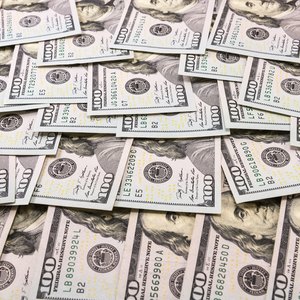
A money order is similar to a check, in that only the person or organization it is made out to should be able to cash it, whether at a U.S. Post Office, check-cashing location or bank. Unlike a check, a money order is prepaid rather than linked to funds in a particular bank account. If you purchased a money order and are concerned that someone aside from the intended recipient has cashed it, you should contact the institution that issued it as soon as possible.
Buying and Cashing Money Orders
A money order can be purchased from the U.S. Postal Service, some banks and companies such as Western Union and MoneyGram. To purchase a money order, you provide the issuing organization with the amount of money, in cash, that you want to send, plus a fee. Then, when the money order is issued, you can sign it and address it to a particular person or organization who will be able to cash it. If you receive a receipt with your money order, you should hang on to it in case the money order is lost or stolen or anything goes wrong.
If someone receives a money order, they can generally cash it through the organization that issued it, through a check cashing or other retail store or deposit it at a bank. For example, you can generally cash a Western Union money order at retail stores with Western Union services and you can cash postal money orders at a post office. To cash a money order, the recipient may be required to present some sort of identification to prove that he or she is actually the person the money order is addressed to.
To deposit a money order at a bank, you can usually visit a bank branch. You can often also deposit the money order through an ATM or a mobile app that enables making deposits by taking photos of checks or money orders.
Lost and Stolen Money Orders
If you lose a money order or are concerned that one has been stolen or cashed by someone other than the intended recipient, you should contact the organization that issued it right away.
The Postal Service will research and potentially replace lost, stolen or damaged money orders, as will companies like Western Union and MoneyGram. These services may charge you a fee to research and replace the money order, and the fee can be larger if you don't have the original receipt.
References
- Capital One: Other Bank Services
- USPS: Domestic & International Money Orders
- Western Union: Money Orders
- MoneyGram: Money Orders
- NerdWallet: Money Orders: When to Use, Where to Get and How to Cash Them
- Wells Fargo: Mobile Deposit Terms and Conditions
- NerdWallet: Lost Money Order? How to Claim Your Cash
- United States Postal Service. "Sending Money Orders." Accessed Jan. 13, 2020.
- Western Union. "Do Money Orders Have an Expiration Date?" Accessed Jan. 13, 2020.
- Western Union. "How Do I Request a Money Order Refund?" Accessed Jan. 13, 2020.
- United States Postal Service. "Money Orders - The Basics." Accessed Jan. 13, 2020.
- United States Postal Service. "Money Order Inquiry System." Accessed Jan. 13, 2020.
- MoneyGram. "Money Order Information." Accessed Jan. 13, 2020.
- MoneyGram. "Money Order Claim Card." Accessed Jan. 13, 2020.
- Western Union. "All About Money Orders." Accessed Jan. 13, 2020.
- Western Union. "Money Order Research Request." Accessed Jan. 13, 2020.
- Office of the Comptroller of the Currency. "Answers About Forgery and Fraud." Accessed Jan. 13, 2020.
Writer Bio
Steven Melendez is an independent journalist with a background in technology and business. He has written for a variety of business publications including Fast Company, the Wall Street Journal, Innovation Leader and Ad Age. He was awarded the Knight Foundation scholarship to Northwestern University's Medill School of Journalism.
